标签:结构 哈希 int flow key值 dex 存在 转化 capacity
Java集合框架是非常普遍使用,也是非常重要的部分,同时也是很基础的部分,熟练掌握很重要,它对于数据的操作提供了良好的接口,下面将从整个集合框架的体系介绍重要的集合框架类,使用方法,以及内部原理。



List接口实现类: |
Map接口实现类 |
Set接口实现类 | Queue接口实现 |
| ArrayList |
HashMap |
HashSet | ArrayDeque |
|
LinkedList |
Hashtable | PriorityQueue | |
|
Vector |
TreeMap | TreeSet | |
|
Stack |
LinkedHashMap |
LinkedHashSet |
*哈希算法: * 0、哈希算法即散列函数,又称哈希函数。它是一种单向密码体制,即它是一个从明文到密文的不可逆的映射,只有加密过程,没有解密过程。同时,哈希函数 * 可以将任意长度的输入经过变化以后得到固定长度的输出。哈希函数的这种单向特征和输出数据长度固定的特征使得它可以生成消息或者数据 * 1、哈希算法将任意长度的二进制值映射为较短的固定长度的二进制值,这个小的二进制值称为哈希值。哈希值是一段数据唯一且极其紧凑的 * 数值表示形式。因此java中每一个对象都有一个hashcode值,用于表明对象的唯一性,可用于比较对象是否相同。 * 2、“===”和equals * 在对象比较的时候我们很容易就纠结用equals方法,还是“==”号,equals用于比较对象的内容或者值,而“==”不仅要比较值还要比较hashcode. * * 3、哈希算法的不可逆和无冲突<hash值,>的特性,让它产生巨大的作用: * 3.1、不同的数据产生的hash值不同: * 用于校验数据的完整性<我们经常下载官网的一些软件时都会又有一个MD5校验码,它是用于校验软件是否被恶意更改>,当然 * 也可以做加密,信息摘要。 * 3.2、哈希表+哈希函数+碰撞冲突处理: * 用于数据的存储和快速查找,<我们只需要一个输入就可以找到数据存储的位置,相比于遍历速度几何倍数提升> * 3.3、常见的hash表的方法 * 4、典型的Hash算法: * MD2、MD4、MD5 和 SHA-1 * 5、得到一个好的hash算法分为两步: * 5.1 构造hash函数:计算值->散列得到坐标/位置<散列法> * 好的hash函数表现是数据冲突尽量少,hash表长度合理。不同的函数产生的表长度是不一样的,hash函数的构造方法也很多,也可 * 以多方法组合使用,最常用的hash函数:http://blog.csdn.net/mycomputerxiaomei/article/details/7641221 * ------- * 除法散列法:ndex = value % 16 * 平方散列法:index = (value * value) >> 28 (右移,除以2^28。记法:左移变大,是乘。右移变小,是除。) * 斐波那契(Fibonacci)散列法 * 5.2 解决碰撞冲突: * 5.2.1开放定址法: * 线性探测再散列: * 二次探测在散列: * 为随机探测再散列: * 5.2.2再哈希法: * 5.2.3链地址法: * 5.2.4建立公共溢出区
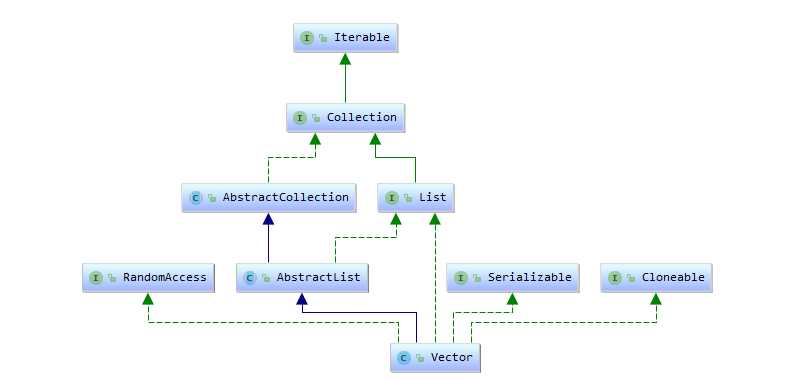
Vector实现了RandomAccess和List接口,可以随机读取,底层是数组实现,拥有和ArrayList性能,但是它实现了线程同步,使用同步锁:sychonrized,在非同步情况下,完全没必要使用,比ArrayList要慢很多。而hashTable也是采用的sychonrized对方法枷锁,且锁定的是整个哈希表,高并发情况下很容易出现瓶颈。相比于单线程使用Vector,hashtable无非是吃力不讨好。而在于并发情况下,已经有更好的线程安全的Map,List,Set,在性能上远超Vector和hashtable。
public class ArrayList<E> extends AbstractList<E> implements List<E>, RandomAccess, Cloneable, java.io.Serializable { private static final long serialVersionUID = 8683452581122892189L; /** * 默认初始空间10 */ private static final int DEFAULT_CAPACITY = 10; /** * 数组的最大容量 */ private static final int MAX_ARRAY_SIZE = Integer.MAX_VALUE - 8; /** *用于存储数据的数组 */ transient Object[] elementData; // non-private to simplify nested class access
private void grow(int minCapacity) { // overflow-conscious code int oldCapacity = elementData.length; //新的容量=old容量+old/2 int newCapacity = oldCapacity + (oldCapacity >> 1); if (newCapacity - minCapacity < 0) newCapacity = minCapacity; if (newCapacity - MAX_ARRAY_SIZE > 0) newCapacity = hugeCapacity(minCapacity); // minCapacity is usually close to size, so this is a win: elementData = Arrays.copyOf(elementData, newCapacity); }
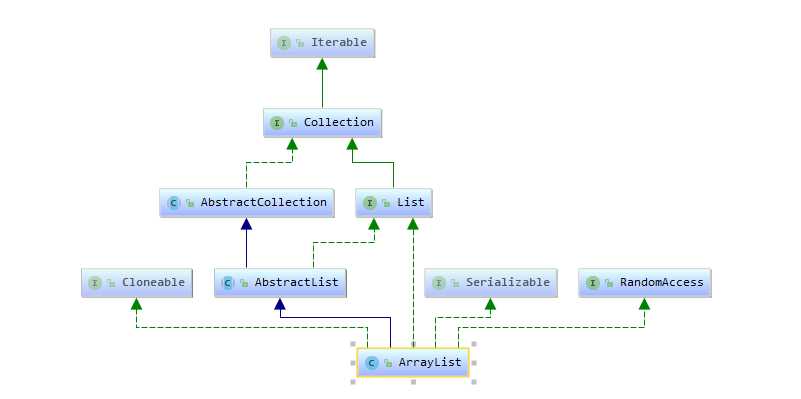
public class LinkedList<E> extends AbstractSequentialList<E> implements List<E>, Deque<E>, Cloneable, java.io.Serializable { transient int size = 0; /** * Pointer to first node.指向头节点 * Invariant: (first == null && last == null) || * (first.prev == null && first.item != null) */ transient Node<E> first; /** * Pointer to last node.指向尾节点 * Invariant: (first == null && last == null) || * (last.next == null && last.item != null) */ transient Node<E> last;
private static class Node<E> { E item; Node<E> next;//指向下一个元素 Node<E> prev;//指向前一个元素 Node(Node<E> prev, E element, Node<E> next) { this.item = element; this.next = next; this.prev = prev; } }
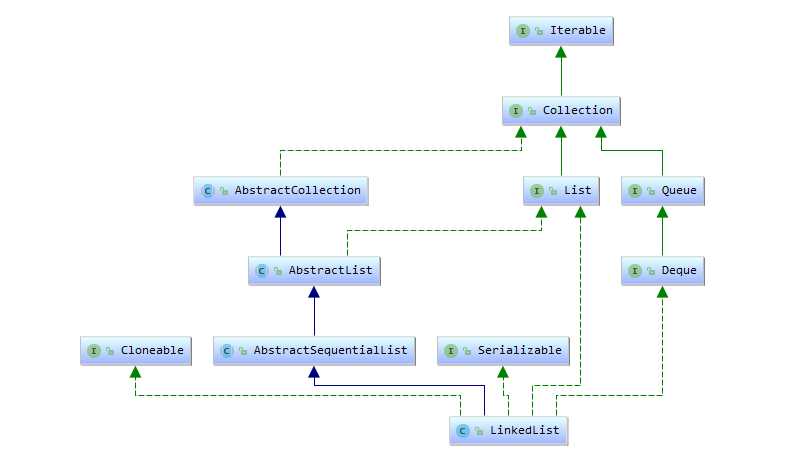
/** * 获取一个线程安全的LinkedList */ List synLinkedList = Collections.synchronizedList(new LinkedList()); /** * 获取一个线程安全的ArrayList */ List synArrayList = Collections.synchronizedList(new ArrayList());
K,V都可为null,存在get返回null的方法并不能确定当前k是否存在(返回null一种代表V==null,一种代表未查询到K,需用containskey)迭代器:Iterator。支持fail-fast

/** * The default initial capacity - MUST be a power of two. * 默认初始容量16,指的是桶的数量(数组的长度),必须是2的N次幂 */ static final int DEFAULT_INITIAL_CAPACITY = 1 << 4; // 16 /** * The maximum capacity, used if a higher value is implicitly specified * by either of the constructors with arguments. * MUST be a power of two <= 1<<30. * 最大的容量,可以在构造的时候传入参数,但是必需是小于2的30次幂=1073741824 */ static final int MAXIMUM_CAPACITY = 1 << 30; /** * The load factor used when none specified in constructor. * 默认的负载因子0.75,即使用容量超过初始容量*0.75必须扩容 */ static final float DEFAULT_LOAD_FACTOR = 0.75f; /** * 链表转红黑树的阈值,大于这个值转换 */ static final int TREEIFY_THRESHOLD = 8; /** * 红黑树转链表的阈值,小于这个值转换 */ static final int UNTREEIFY_THRESHOLD = 6;
负载因子的默认值是0.75, 它平衡了时间和空间复杂度。 负载因子越大会降低空间使用率,但提高了查询性能(表现在哈希表的大多数操作是读取和查询)
/** * 哈希表,每个节点是Node<K,V>结构,容量总是保持2的N次幂。 */ transient Node<K,V>[] table;
数组的每个节点Node又是一个链表存储下一个节点的位置Next,这个Next仍然是个Node:这种结构决定了头插法来链接链表的节点。同时也解决了我们的一个困惑,以往在get的时候以为节点只存储了Value,Node说明了它连K,V一起存储的,碰撞的时候hash值相同,我们也可以比较K的值来确定要返回的Value
static class Node<K,V> implements Map.Entry<K,V> { final int hash; final K key; V value; Node<K,V> next; }
static final int hash(Object key) { int h; return (key == null) ? 0 : (h = key.hashCode()) ^ (h >>> 16); }
final Node<K,V>[] resize() { Node<K,V>[] oldTab = table; int oldCap = (oldTab == null) ? 0 : oldTab.length;//旧表容量 int oldThr = threshold; int newCap, newThr = 0; if (oldCap > 0) { if (oldCap >= MAXIMUM_CAPACITY) {//容量达到最大值 threshold = Integer.MAX_VALUE;//把扩展阈值修改为最大,这样以后就不能扩容了 return oldTab; } else if ((newCap = oldCap << 1) < MAXIMUM_CAPACITY && oldCap >= DEFAULT_INITIAL_CAPACITY) newThr = oldThr << 1; // double threshold 阈值翻倍 } else if (oldThr > 0) // initial capacity was placed in threshold newCap = oldThr; else { // zero initial threshold signifies using defaults newCap = DEFAULT_INITIAL_CAPACITY; newThr = (int)(DEFAULT_LOAD_FACTOR * DEFAULT_INITIAL_CAPACITY); } if (newThr == 0) { float ft = (float)newCap * loadFactor; newThr = (newCap < MAXIMUM_CAPACITY && ft < (float)MAXIMUM_CAPACITY ? (int)ft : Integer.MAX_VALUE); } threshold = newThr; @SuppressWarnings({"rawtypes","unchecked"}) Node<K,V>[] newTab = (Node<K,V>[])new Node[newCap]; table = newTab; if (oldTab != null) { for (int j = 0; j < oldCap; ++j) { Node<K,V> e; if ((e = oldTab[j]) != null) { oldTab[j] = null; if (e.next == null) newTab[e.hash & (newCap - 1)] = e; else if (e instanceof TreeNode) ((TreeNode<K,V>)e).split(this, newTab, j, oldCap); else { // preserve order Node<K,V> loHead = null, loTail = null; Node<K,V> hiHead = null, hiTail = null; Node<K,V> next; do { next = e.next; if ((e.hash & oldCap) == 0) { if (loTail == null) loHead = e; else loTail.next = e; loTail = e; } else { if (hiTail == null) hiHead = e; else hiTail.next = e; hiTail = e; } } while ((e = next) != null); if (loTail != null) { loTail.next = null; newTab[j] = loHead; } if (hiTail != null) { hiTail.next = null; newTab[j + oldCap] = hiHead; } } } } } return newTab; }
/** * Implements Map.get and related methods * * @param hash hash for key * @param key the key * @return the node, or null if none */ final Node<K,V> getNode(int hash, Object key) { Node<K,V>[] tab; Node<K,V> first, e; int n; K k; if ((tab = table) != null && (n = tab.length) > 0 &&(first = tab[(n - 1) & hash]) != null) { if (first.hash == hash && // always check first node ((k = first.key) == key || (key != null && key.equals(k)))) return first; if ((e = first.next) != null) { if (first instanceof TreeNode)//如果是树形Node,则调用TreeNode的get方法 return ((TreeNode<K,V>)first).getTreeNode(hash, key); do {//否则直接查询Next比较Key值。 if (e.hash == hash && ((k = e.key) == key || (key != null && key.equals(k)))) return e; } while ((e = e.next) != null); } } return null;//查询不到返回null }+
/** * Implements Map.put and related methods * * @param hash hash for key * @param key the key * @param value the value to put * @param onlyIfAbsent if true, don‘t change existing value * @param evict if false, the table is in creation mode. * @return previous value, or null if none */ final V putVal(int hash, K key, V value, boolean onlyIfAbsent, boolean evict) { Node<K,V>[] tab; Node<K,V> p; int n, i; if ((tab = table) == null || (n = tab.length) == 0) n = (tab = resize()).length; if ((p = tab[i = (n - 1) & hash]) == null) tab[i] = newNode(hash, key, value, null); else { Node<K,V> e; K k; if (p.hash == hash &&((k = p.key) == key || (key != null && key.equals(k))))//hash,k都相同,节点覆盖掉 e = p; else if (p instanceof TreeNode)//如果是树形Node调用putTreeNode方法 e = ((TreeNode<K,V>)p).putTreeVal(this, tab, hash, key, value); else {//否则链表Node链接 for (int binCount = 0; ; ++binCount) { if ((e = p.next) == null) { p.next = newNode(hash, key, value, null); if (binCount >= TREEIFY_THRESHOLD - 1) // -1 for 1st,当节点容量bincount>=转化因子的时候转化成红黑树结构 treeifyBin(tab, hash); break; } if (e.hash == hash && ((k = e.key) == key || (key != null && key.equals(k)))) break; p = e; } } if (e != null) { // existing mapping for key V oldValue = e.value; if (!onlyIfAbsent || oldValue == null) e.value = value; afterNodeAccess(e); return oldValue; } } ++modCount; if (++size > threshold) resize(); afterNodeInsertion(evict); return null; }

public class Hashtable<K,V> extends Dictionary<K,V> implements Map<K,V>, Cloneable, java.io.Serializable { /** * The hash table data. */ private transient Entry<?,?>[] table; }
/** * Hashtable bucket collision list entry */ private static class Entry<K,V> implements Map.Entry<K,V> { final int hash; final K key; V value; Entry<K,V> next; protected Entry(int hash, K key, V value, Entry<K,V> next) { this.hash = hash; this.key = key; this.value = value; this.next = next; }
/** * Constructs a new, empty hashtable with a default initial capacity (11) * and load factor (0.75). */ public Hashtable() { this(11, 0.75f); }
public synchronized V get(Object key) { Entry<?,?> tab[] = table; int hash = key.hashCode(); int index = (hash & 0x7FFFFFFF) % tab.length;//索引位置计算 for (Entry<?,?> e = tab[index] ; e != null ; e = e.next) { if ((e.hash == hash) && e.key.equals(key)) { return (V)e.value; } } return null; }
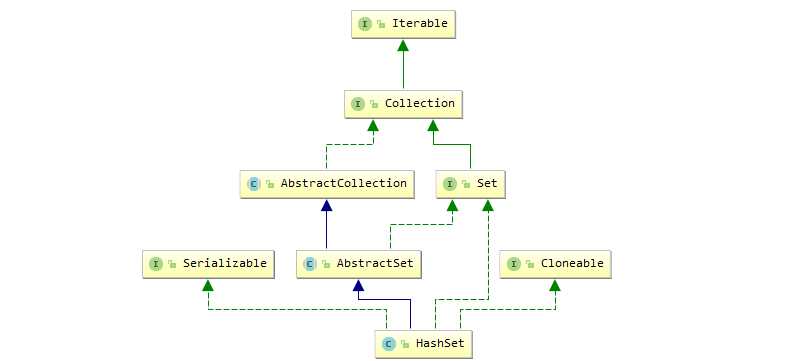
public HashSet() {//无参构造直接构造一个hashmap map = new HashMap<>(); } public HashSet(Collection<? extends E> c) {//传入集合直接调用hashmap的默认参数构造map map = new HashMap<>(Math.max((int) (c.size()/.75f) + 1, 16)); addAll(c); } public HashSet(int initialCapacity, float loadFactor) { map = new HashMap<>(initialCapacity, loadFactor); } HashSet(int initialCapacity, float loadFactor, boolean dummy) {//使用LinkedHashmap构造 map = new LinkedHashMap<>(initialCapacity, loadFactor); }
// Dummy value to associate with an Object in the backing Map private static final Object PRESENT = new Object();
public boolean add(E e) { return map.put(e, PRESENT)==null; }
Collections.synchronizedMap(new HashMap<Object, Object>()); Collections.synchronizedMap(new LinkedHashMap<Object, Object>()); Collections.synchronizedSet(new HashSet<Object>()); Collections.synchronizedSet(new TreeSet<Object>());
HashMap与HashTable最大的区别在于hashtable是线程安全的,HashMap数据结构也经过不断地优化,就链表结构转红黑树的在极端情况带来的性能提升就是很大的进步。所以在线程安全的情况下首选hashMap存储K-V键值对,存储单值选hashSet(前提是数据不重复,否则就会丢失数据)查找速度理想是O(1)。hashMap K-V都可为null,hashTable K-V都不能够为null.
Enumeration 是JDK 1.0添加的接口。使用到它的函数包括Vector、Hashtable等类,这些类都是JDK 1.0中加入的,Enumeration存在的目的就是为它们提供遍历接口。Enumeration本身并没有支持同步,而在Vector、Hashtable实现Enumeration时,添加了同步。
Iterator 是JDK 1.2才添加的接口,它也是为了HashMap、ArrayList等集合提供遍历接口。Iterator是支持fail-fast机制的:当多个线程对同一个集合的内容进行操作时,就可能会产生fail-fast事件。
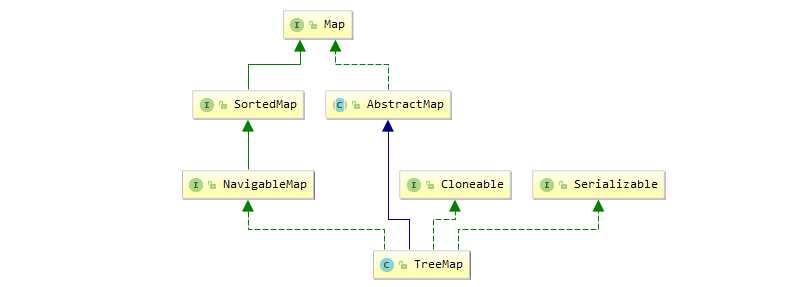
/** * The comparator used to maintain order in this tree map, or * null if it uses the natural ordering of its keys. * * @serial */ private final Comparator<? super K> comparator; /** * 构造一个带比较器的Treemap */ public TreeMap(Comparator<? super K> comparator) { this.comparator = comparator; }
final Entry<K,V> getEntry(Object key) { // Offload comparator-based version for sake of performance if (comparator != null) return getEntryUsingComparator(key); if (key == null) throw new NullPointerException(); @SuppressWarnings("unchecked") Comparable<? super K> k = (Comparable<? super K>) key; Entry<K,V> p = root; while (p != null) { int cmp = k.compareTo(p.key); if (cmp < 0) p = p.left; else if (cmp > 0) p = p.right; else return p; } return null; }
完全是基于一个树的查找。put操作也一样是基于树的插入操作。。
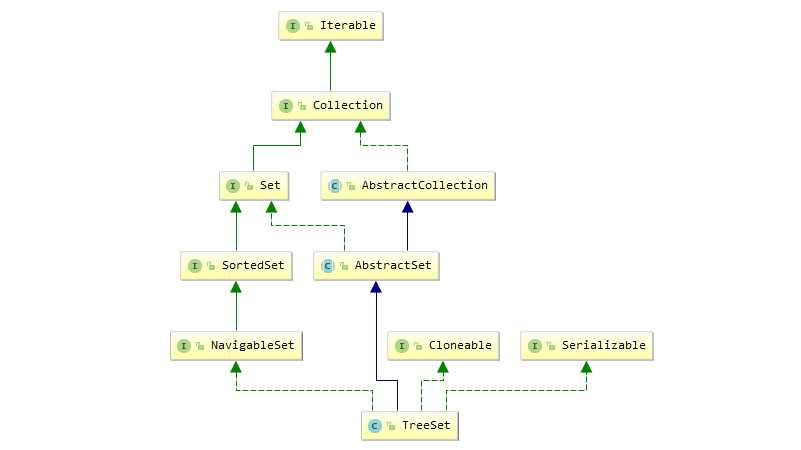
public TreeSet() { this(new TreeMap<E,Object>()); }
Map synmap = Collections.synchronizedMap(new HashMap<Object, Object>()); if(synmap.containsKey(K)){//synmap.containsKey(K)安全的操作 ....... //这是个不安全的位置,因为这个空挡期间,可能有多个线程进入到了这里,其中一个执行remove之后,其他线程就会报错 synmap .remove(K);//安全的操作: }
所以要保证上面操作的安全性必须给整个操作枷锁。等等一些和删除,修改相关的操作都可能会出现类似的问题。
标签:结构 哈希 int flow key值 dex 存在 转化 capacity
原文地址:http://www.cnblogs.com/NextNight/p/6972172.html